Paddlers, I’m sure you know this long debate about paddles. Feathered or unfeathered paddles?
Some people claim paddling with feathered paddle is odd, while others claim paddling with unfeathered paddle is basic.
For Team feathered paddles, does the argument really valid? In contrast, if you were using an unfeathered paddle, would that mean you HAVE to switch to using a feathered paddle?
This long debate seems never end. Is it true that feathered paddle is better than the unfeathered paddle?
In fact, a more relevant question to paddlers: Should You Feather Your Paddle?
Well, let’s discuss the arguments for both feathered and unfeathered paddles and see which paddle is for you!
1. Arguments for feathered paddle
Team feathered paddle, this is where you shine. You know why you use a feathered paddle and these are the reasons.
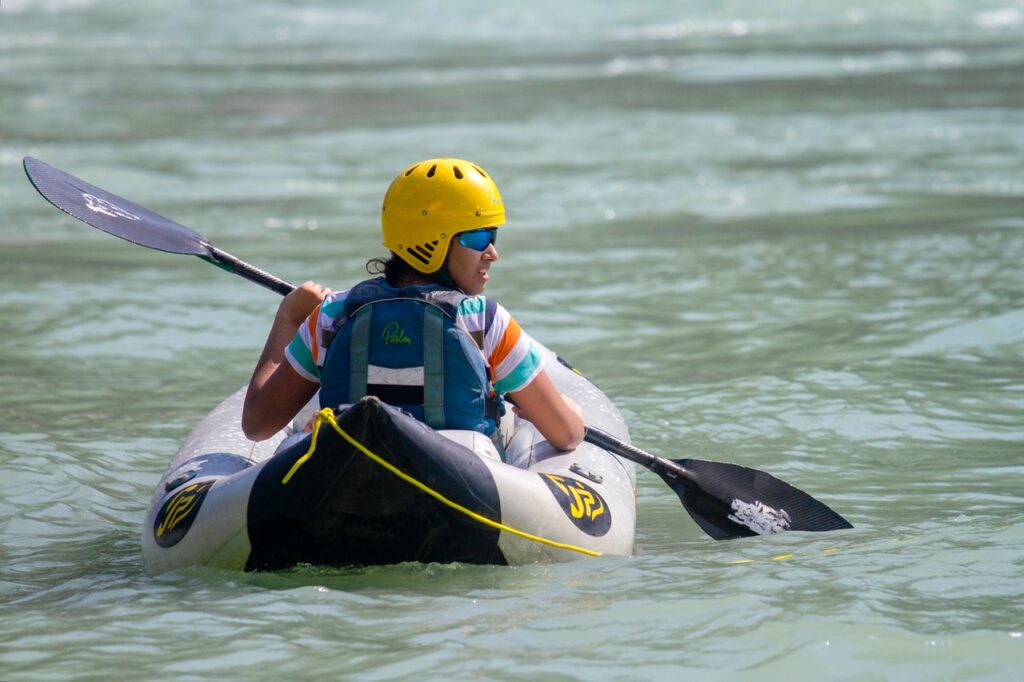
1.1 Aerodynamic
Kayaking is essentially the same as riding a bike. Notice the posture of road bike cyclists. So, you know why you use a feathered paddle.
This is all about AERODYNAMIC. Hands down!
Ok. Let’s picture this in your mind. Paddling is like drawing circles on both sides. Half of the circles are in the water, and another half are in the air.
Pay attention to the semi-circles in the air. When the kayak is moving through the water under an UPWIND condition, the paddle is “travelling” through the air, meaning the air particles hit the paddle.
This creates friction and causes air resistance. This restricts the speed of moving forward. As a result, the paddlers need to paddle harder to propel the kayak faster. – This happens when the paddler uses an unfeathered paddle.
And, this is the purpose of using a feathered paddle. A feathered paddle makes the blade perpendicular to the direction of the wind, so to reduce the friction and air resistance. – Translation, it is more efficient and the kayak can move faster.
Hence, you notice most of the professional paddlers, if not all, use feathered paddles. – Talk about the importance of timing to be the champion or break the record.
1.2 Dominant hand
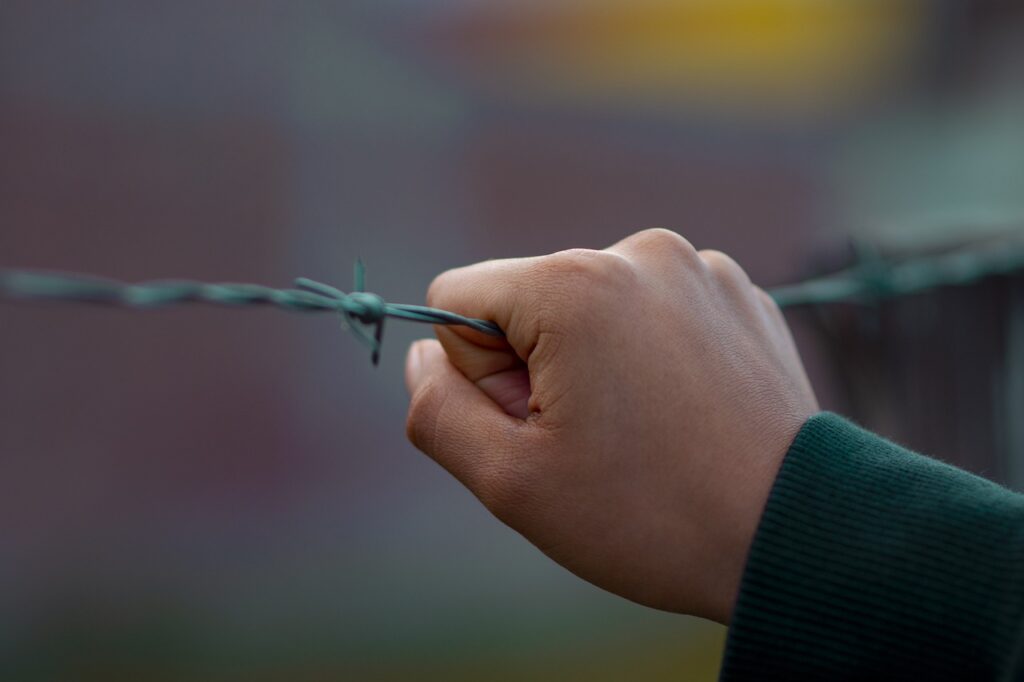
We have a dominant hand, left-handed or right handed, and this is the fact. No argument.
And, if you look at the professional paddlers paddle, their paddling looks SYMMETRICAL. In fact, their paddling technique isn’t “symmetrical” to make their paddling look symmetrical.
Meaning, the paddlers account the dominant hand factor to paddle so that the paddling looks symmetrical. This means the way to hold the feathered paddles is slightly different from unfeathered paddles.
Though it might not be necessary to use feathered paddles to move in a straight line, the power of our hands are not identical. In other words, our dominant hand has stronger power.
As such, there’s a general principle for paddle holding: lock the grip of the dominant hand and let the non-dominant hand loose.
That is ERGONOMIC. You’ll fully utilize this perk when you are using a feathered paddle. While “locking” the dominant hand grip, twist the wrist of the dominant hand to navigate the direction of the blade.
This ensures the blade to always be perpendicular to the wind, to reduce the air resistance.
1.3 Wrist strain doesn’t always relate to feathered paddles
Alright. Many people believe that using a feathered paddle can increase the chance of wrist strain or injury. They blame the way to twist the dominant hand very often.
Is that true? – Maybe not.
There is another school of thought. Feathered paddle doesn’t directly cause the wrist problem, but the improper technique of holding the paddle does.
This is a sensible argument as this explains paddlers who use unfeathered paddles can also have wrist problem. In fact, they might have more serious wrist problem if they take this for granted and don’t correct the way to hold the paddles.
The core wrist problem is due to grapping the shaft too tightly, which overstrains the wrist and causes the wrist bending at an odd angle.
So, manage the wrist strain is feasible for feathered paddles. Never ever hold the shaft too tightly, though locking our dominant hand.
To further reduce the wrist problem, paddlers can consider using a bent-shaft feathered paddle, so the grips are in NEUTRAL position. – And this further lessens the strain of wrist.
Well, paddlers can manage the issue while are able to paddle at a greater speed. – So, why not?
1.4 High-angle paddling
Paddling style has a close relation with the choice of using feathered or unfeathered paddles. Feathered paddles usually complement with the HIGH-ANGLE paddling.
How?
Again, imagine this. For high-angle paddling, the semi-circle in the air is BIG, so as the motion. Then, more air particles hit the blade. – Inherently, it has greater air resistance.
Besides, I believe you also know the relationship between paddling style and the shape of the blade. Technically, short and wide blades are more suitable for high-angle paddling, due to the need of POWERFUL paddling.
As the blades are short and wide, it forms a great surface area. Meaning, more air particles hit the blades and further enhance the air resistance.
Right now, you can see this is the RECIPE for slow paddling when using unfeathered paddle.
So, this is the exact reason why feathered paddles are preferable for high-angle paddling!
2. Arguments for unfeathered paddle
Team unfeathered paddle, don’t worry. It doesn’t mean feathered paddles are always better and you must switch to feathered paddles. You should feel more comfortable and confident when using an unfeathered paddle because of the following reasons.
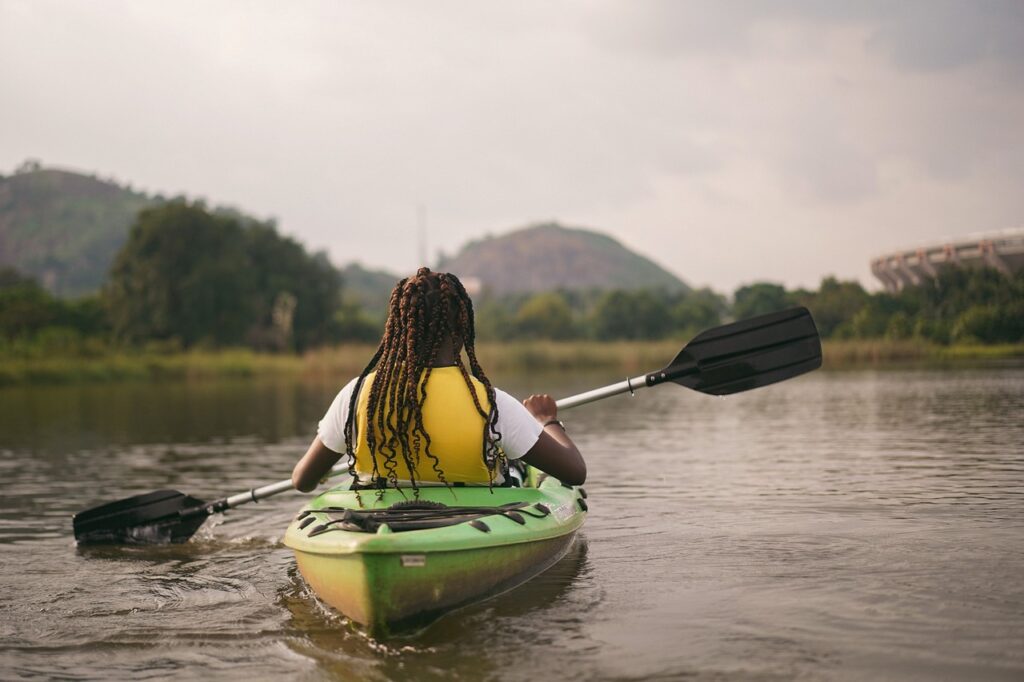
2.1 Intuitive
Surprisingly, paddling with unfeathered paddles is much easier and more straightforward than feathered paddles.
Paddling is symmetrical. How you navigate the paddle on the left hand side should be the same as the right hand side. This is why we call “INTUITIVE”.
Just give an unfeathered paddle to a paddler. Without considering the technique, most probably the paddler can use the paddle without any issue.
Ask anyone who just starts kayaking and what their preference is. You’ll definitely come to know that MAJORITY prefer unfeathered paddles. It is because using an unfeathered paddle is much simpler and requires less brain energy.
Thus, it is a better choice for beginners when they start kayaking. They don’t have to worry about the technical way to paddle as that might demotivate them from kayaking.
2.2 Feathered paddles are troublesome
Let’s face it. Using feathered paddles is more troublesome and difficult. And, here are the common reasons.
Well, if you use an unfeathered paddle, you don’t have to worry about these issues, AT ALL!
2.2.1 Learn the “ergonomic” paddling
Though feathered paddles are ergonomic, it takes time to learn that way as our brain needs to accommodate the COORDINATION of both dominant and non-dominant hands.
When you start using feathered paddle, you need to constantly be mindful on the navigation. Else, you fall back to the original intuition. Then you notice your paddling is really AWKWARD.
It is perfectly fine if your purpose is to learn the “ergonomic” paddling. But, what if this really upsets you and you don’t feel comfortable at all, do you want to force yourself continue learning this way?
After all, you wanna enjoy paddling. That is your ultimate motive.
2.2.2 Offset the paddle angle
Offset the paddle is confusing. For those who are not familiar with this, offset means feather the shafts to a certain angle, so the blades are tilted at that angle with each other. In other words, offset is only applicable to feathered paddles.
Let’s ask paddlers on the PERFECT offset angle of the paddle. You’ll get different kinds of answers! – In other words, “it depends”.
In an IDEAL situation, the best angle would be 90 degree because it is when the blades cut through the air the BEST way, hence the LEAST air resistance.
However, there are various factors in determining the optimal angle. For example, the paddling style, occasion of kayaking, and the flexibility of the torso can greatly influence the offset angle.
Therefore, some people suggest offsetting at 30 degree while others suggest offsetting at 60 degree. It really depends INDIVIDUALLY. – What is suitable for them may not be suitable for you.
So, you need to have a lot of trials and time to find out what your “best” offset angle is, by taking into the consideration of all possible factors.
2.2.3 Left-feathered paddle is less common
Since most people are right-handed, right-feathered paddles are more common than left-feathered paddles. In other words, it is harder for left-handed people to find left-feathered paddles. – Though you can find a paddle which can be feathered both side.
Some people argue that it doesn’t matter whether you are left-handed or right-handed. Since beginners don’t have any kayaking experience, they wouldn’t know which hand is dominant. Hence, they can learn to use the right-feathered paddle just fine!
As a result, many left-handed people are forced to use the right-feathered paddles.
But, I beg to differ.
If the argument above is valid, why not left-feathered paddles are more common than right-feathered paddles? So, right-handed people can learn to use left-feathered paddles, right?
Yes, we don’t have any kayaking experience yet, but we know the “sorta” dominant hand from our daily lives. I believe this has influence in determining the dominant hand when it comes to kayaking.
Likewise, inherently, left-handed people have the obstacles in learning right-handed dominant activities, such as playing violin, golf, guitar, etc….. And of course kayaking. Yes, they can learn, but they need more effort in learning. – Sorta unfair disadvantage to Us. Yeah, I’m left-handed!
However, do note that this is just a general situation and may not apply to all people. There are exceptions where left-handed people can use right-feathered paddles without any issue at all.
2.2.4 Brace stroke
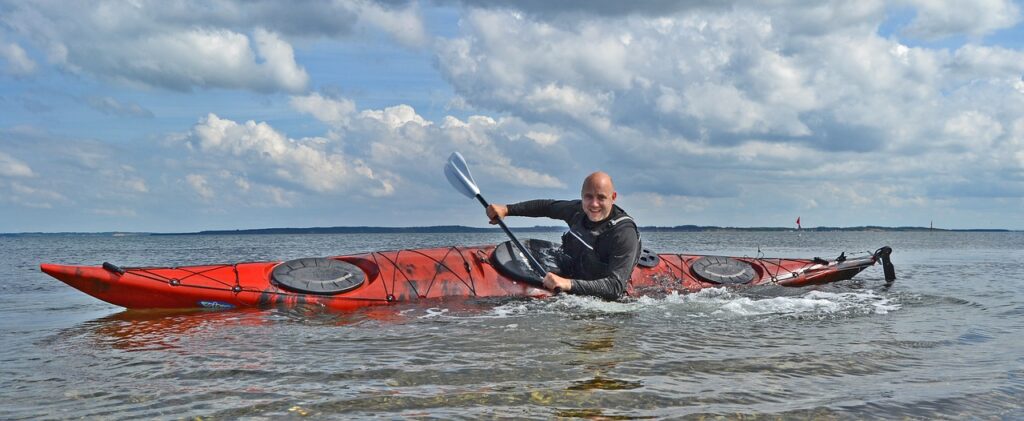
There is an interesting observation. When it comes to bracing, paddlers with unfeathered paddles will face no issue.
But, if the paddler used a right-feathered paddle, he might fall to the right side. Same applies to the left-feathered paddle.
In other words, using feathered paddles makes it easier to brace on one side, and harder on the other side.
Since there are more right-feathered paddles out there, it is not difficult to understand that right-hand brace stroke is an obstacle to the paddlers, especially the beginners.
So, it takes more time to learn the brace stroke on the weaker side, especially the right side.
2.3 Wrong perception that “feathered” is superior
We watch international kayaking competitions. We can HARDLY find a paddler who is using an unfeathered paddle. Then, we have this perception in our mind: feathered paddle is superior and should only be used by professional paddlers.
So, we subconsciously believe that and we try to learn to use feathered paddles.
Here comes the question. Does that mean we MUST switch to feathered paddle if we want to move to the next level? – I don’t think there is a right answer.
While it is common to see paddlers switch to feathered paddles, some experienced paddlers actually switch to unfeathered paddle. – This is totally the opposite of the norm.
They realize that unfeathered paddles are actually a better option for them, by comparing the experience of using both paddles.
Also, there is Green Land Paddle, a long and slim symmetrical unfeathered paddle. It is very popular in touring or sea kayaking and is very “efficient” and energy conserving.
2.4 Low-angle paddling
This is exactly the opposite of high angle paddling.
While paddling low-angled, the semi-circle in the air is SMALL, so as the motion. Hence, fewer air particles hit the blade. –So, it has lower air resistance.
Furthermore, long and narrow blades are more suitable for low-angle paddling. As the blades are long and narrow, it forms a small surface area. So, fewer air particles hit the blade and hence minimal air resistance.
Thus, air resistance is not the main concern for low-angle paddling. In this case, you can just use unfeathered paddle without any issue.
2.5 Downwind paddling
If feathered paddles are beneficial for upwind paddling, then we can say unfeathered paddles are beneficial for downwind paddling. – Here how it works.
People argue that paddling upwind can cause great air resistance when using an unfeathered blade. Likewise, paddling downwind can create air ASSISTANCE.
Meaning, the air particles will push the blade to create additional force to propel the kayak.
Of course, you won’t experience this when using a feathered paddle as the air assistance is insignificant or close to none.
3. Should you feather the paddle?
Hm…… It really DEPENDS. There is not right or wrong. But, I believe you already have an idea, don’t you?
If not, perhaps you can look for the following factors for guidance.
3.1 Comfort
The ultimate purpose is to paddle with comfort, simple as that. With all that being said, it is pointless if you weren’t comfortable with feathered paddle, and vice versa.
Most people find unfeathered paddles much easier and more comfortable to use. – So, go ahead.
Some people find the opposite is true. They are better in paddling with their control hand. – So, it is PERFECTLY fine to use feathered paddles.
Everyone is unique. What is suitable for them may not be suitable for you. Test them out and compare.
3.2 Paddling style
Your paddling style dictates which paddles are suitable for you.
Generally, like mentioned above, use feathered paddles for high-angle paddling; use minimal feathered or unfeathered paddles for low-angle paddling.
3.3 Purpose of paddling
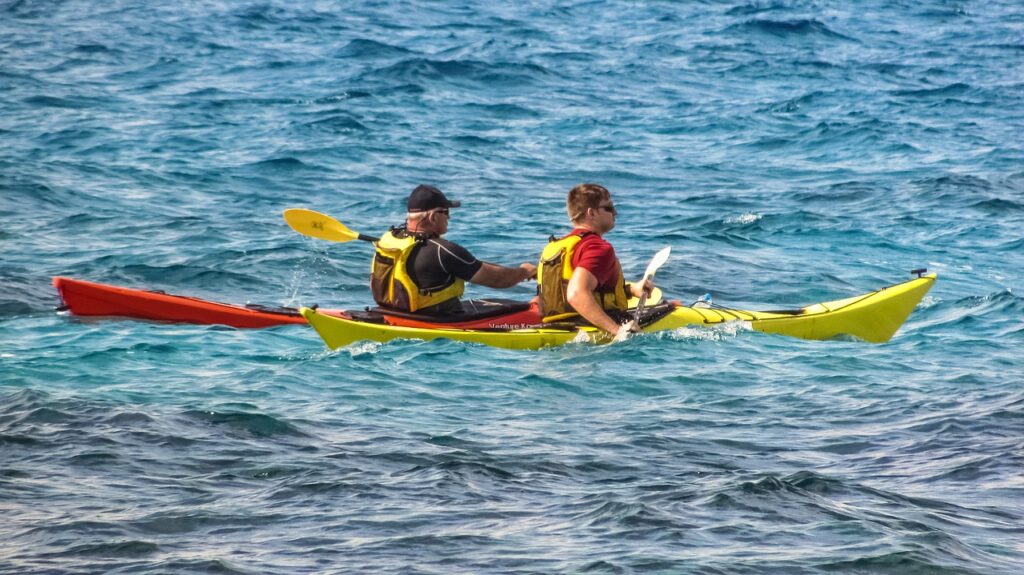
Similar to the paddling style.
For relaxing paddling, you could consider using an unfeathered paddle as you don’t have to worry about the air resistance.
For aggressive paddling, feathered paddle is your choice as you want to reduce air resistance for better paddling efficiency.
In fact, both paddles are suitable for all kayaking occasions. Ultimately, it really depends on your PREFERENCE and comfort on using the paddles.
For example, there is nothing wrong if you use a feathered paddle when chilling on the lake. Likewise, nothing stops you from using an unfeathered paddle for aggressive paddling.
3.4 Types of paddle
Most paddles can either be feathered or unfeathered. But, if your main concern is to use Greenland paddle, then you don’t have to consider using a feathered paddle.
The reason is simple. You won’t find a feathered Greenland paddle because this paddle is already effective in its design. You don’t have to twist your dominant grip like using a feathered paddle.
Final thought: feathered or unfeathered paddles
Let’s try both paddles and see which one is more comfortable and natural for you. By doing this, you know your preference and choose the right type of paddle for yourself.
With the increasing number of people using unfeathered paddles, I really long to see professional paddlers paddle with unfeathered paddles in the competitions someday. Well, both paddles should shine on their own way, and not be superior to each other.
Relevant posts
